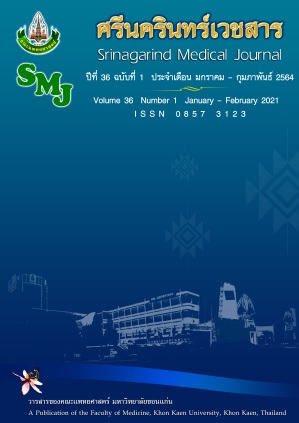Assessment of the Entrance Skin Radiation Dose from the Digital Radiography in Srinagarind Hospital
Keywords:
Digital Radiography; Entrance Skin Dose; Diagnostic reference levelAbstract
Background and objectives: Digital radiography is a common diagnostic practice and it has been a significant increase in the number of x-ray examinations. Patients were frequently exposed to radiation may consider increasing the risk of exposure to radiation. The purpose of this study was set up to evaluate the entrance skin dose (ESD) in common digital radiography in Srinagarind hospital, faculty of medicine, Khon Kaen university and compared to ESD with national and international diagnostic reference level (DRL) including study of parameters which effect the ESD.
Material and method: The retrospective study was conducted from January to May 2019 by using picture achieving communication systems (PACS). The digital radiographic parameters from total 1,010 patients from 12 examinations including chest, cervical spine, thoracic spine and lumbar spine, skull in anteroposterior/posteroanterior (AP/PA) view and lateral view, abdomen and pelvis in AP view were recorded. The ESD was calculated using the specific formula. All data were analyzed using descriptive analysis and the correlation of digital radiographic parameters and ESD was also analyzed.
Result: The result showed that the highest kVp for DR was observed in chest LAT while the highest mAs was observed in lumbar spine LAT. The median ESD of all digital radiography examination was lower than the international IAEA DRL value while the median of ESD of chest PA, abdomen AP, pelvis AP, lumbar spine LAT and skull AP/PA was lower than Thai national DRL except for the median ESD of lumbar spine AP and skull LAT were higher than national DRL. Moreover, the median ESD was compared with the Japanese and United Kingdom (UK) DRL. The comparison between ESD and Japanese DRL was showed the result like the Thai national DRL. While the comparison between ESD and UK DRL, the median ESD of abdomen AP, pelvis AP and lumbar spine LAT were lower than UK DRL except for the median ESD of chest PA, lumbar spine AP, skull AP/PA and skull LAT were higher than UK DRL. In addition, mAs showed a high positive correlation with ESD while weight, age and kVp were showed a low correlation with ESD.
Conclusion: This study provided the median ESD in Srinagarind hospital and already compared with national DRL, international IAEA DRL, Japanese DRL and UK DRL. When the median ESD was higher than national and international DRL, technologist and team member could investigate and determine the cause of problem. The quality assurance program and efficiency of X-ray machine firstly check to ensure the good performance of the machine and radiation output and then the protocol and exposure technique were also revised. Further step, dose optimization is required to reduce the patient dose and limit the stochastic effect risk.
References
2. Wunderle K, Gill AS. Radiation-related injuries and their management: an update. In: Seminars in interventional radiology. Thieme Medical Publishers; 2015: 156.
3. Vañó E, Miller DL, Martin CJ, Rehani MM, Kang K, Rosenstein M, et al. ICRP Publication 135: Diagnostic Reference Levels in Medical Imaging. Ann ICRP 2017; 46: 1–144.
4. Vassileva J, Rehani M. Diagnostic reference levels. Am J Roentgenol 2015; 204: W1–3.
5. Tonkopi E, Daniels C, Gale MJ, Schofield SC, Sorhaindo VA, VanLarkin JL. Local diagnostic reference levels for typical radiographic procedures. Can Assoc Radiol J. 2012; 63: 237–241.
6. วิชัย วิชชาธรตระกูล, สมศักดิ์ วงษ์ศานนท์, บรรจง เขื่อนแก้ว. ปริมาณรังสีที่ผิวหนังของผู้ป่วยที่ได้รับจากการถ่ายภาพรังสีทรวงอก ในโรงพยาบาลศรีนครินทร์ คณะแพทยศาสตร์ มหาวิทยาลัยขอนแก่น. ศรีนครินทร์เวชสาร 2553; 25: 120–124.
7. Yacoob HY, Mohammed HA. Assessment of patients X-ray doses at three government hospitals in Duhok city lacking requirements of effective quality control. J Radiat Res Appl Sci 2017; 10: 183–187.
8. Mukaka MM. A guide to appropriate use of correlation coefficient in medical research. Malawi Med J 2012; 24: 69–71.
9. ศิริวรรณ บุญชรัตน์ , ภัทรพงศ์ เหมัษฐิติ. ค่าปริมาณรังสีอ้างอิงจากการถ่ายภาพรังสีวินิจฉัย ด้วยเครื่องเอกซเรย์ทั่วไป (Diagnostic reference levels in General radiography) สำนักรังสีและเครื่องมือแพทย์.วารสารวิชาการสาธารณสุข 2559; 25(4): 632-640.
10. Organization WH. International basic safety standards for protecting against ionizing radiation and for the safety of radiation sources. Printed by the IAEA in Austria: 1996; 279.
11. Yonekura Y. Diagnostic reference levels based on latest surveys in Japan–Japan DRLs 2015. Jpn Netw Res Inf Med Expo; 2019: 1–11.
12. Hart D, Hillier MC, Shrimpton PC. Doses to Patients from Radiographic and Fluoroscopic X-ray Imaging Procedures in the UK–2010 review HPA-CRCE-034. Chilton HPA; 2012.
13. ลัดดา เย็นศรี. การศึกษาเปรียบเทียบปริมาณรังสีที่ผู้ป่วยได้ รับจากการถ่ายภาพรังสีทรวงอกด้วยระบบ CR และ DR. South Coll Netw J Nurs Public Health 2016; 3(1): 129–39.
14. Aliasgharzadeh A, Mihandoost E, Masoumbeigi M, Salimian M, Mohseni M. Measurement of entrance skin dose and calculation of effective dose for common diagnostic x-ray examinations in Kashan, Iran. Glob J Health Sci 2015; 7: 202.
15. Ofori K, Gordon SW, Akrobortu E, Ampene AA, Darko EO. Estimation of adult patient doses for selected X-ray diagnostic examinations. J Radiat Res Appl Sci 2014; 7(4): 459–462.
16. Suliman II, Mohammedzein TS. Estimation of adult patient doses for common diagnostic X-ray examinations in Wad-madani, Sudan: derivation of local diagnostic reference levels. Australas Phys Eng Sci Med 2014; 37(2): 425–429.
17. Bushong SC. Radiologic science for technologists-E-book: Physics, Biology, and Protection. Elsevier Health Science; 2013; 161-185.




